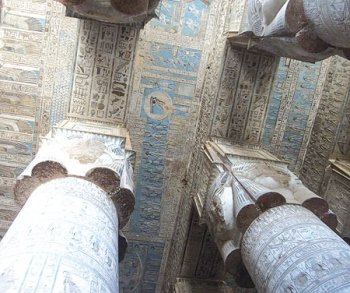Dendera Temple
About 50 miles upstream from Abydos is Dendera, one of the great monuments of Ancient Egypt; on the way from the north to the south one passes the strangely named Egplum, where with the aid of Russia a great complex is being developed for manufacturing aluminium.

Dendera was sacred to Hathor, a goddess who is represented in many forms though usually at Dendera with woman's head & cow's ears. She had a particular link with Horus, the god whom we will meet at Edfu.
The interest of Dendera is, first that its temple is one of the best preserved in Egypt & secondly that it is of very late date.
But Dendera, though its temple is, comparatively, of modern date, is not a modern site. It is in fact one of the most ancient of religious centers. But the oldest surviving structure, the so called Birth House (or Mammisi) of Nectanebo, is only of the 30thdynasty, shortly antedating the Ptolemies. A 2nd Birth House, of Roman times, lies near it & between them is a remarkable Coptic church thought to date from the 5th century AD. The other relics at Dendera – the great temple apart – are a temple of Isis & a sacred Lake.

The great temple was building from the 2nd century BC. to the 2nd century AD.
We enter through a great, but damaged, gateway passing on the right the Birth Houses & the Coptic church, we reach the great courtyard & then the façade of the Hypostyle Hall. Inside the Hall is a forest of Hathor-headed columns, while the walls are decorated with reliefs of the Roman age. The king or Pharaoh or Emperor, who is the central figure of these scenes, participates in ceremonies with many of the ancient gods. The ceiling of the hall is a kind of panorama of astronomy covers it, with the signs of the zodiac, the winds, the months, the hours, & of course the gods elaborately displayed.
There are 2 features at Dendera that are worth noticing. First, the capitals of the great columns, these unusually are in 2 parts; the face of Hathor gazes out in 4 directions; above her head is a kind of square box with elegant reliefs. Secondly, the arrangement of the decoration on the temple walls. Here we are conscious of a decorative plan & great symmetry, they are sunk reliefs or raised reliefs, some of these reliefs, being in big scale, are refined & effective.

From the hypostyle Hall we continue into a 2nd & smaller Hall flanked by service rooms. Next comes 2 Vestibules & the most sacred part of the temple, the Sanctuary.
The tour is completed by visits to the vaults & the roofs. There are 12 crypts have reliefs….
Very grand reliefs also decorate the staircase by which one ascend to the roof.
On the outside of the temple the reliefs have historical interest. The south wall portrays the famous Cleopatra, Julius Caesar & their son Caesarion.